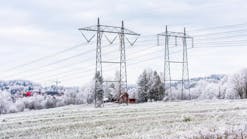The European Investment Bank (EIB) and the European Union will provide financial assistance of €330 million (about US$398 million) for an interconnector project between hydroelectric power plants in Guinea and Mali that will provide millions in West Africa access to clean and affordable energy
A 225-kV, 340-km transmission line traversing Guinea from west to east, between the Linsan (Labé region) and Fomi (Kankan region) substations, will link the Kaléta and Souapiti hydroelectric power plants (total capacity of 690 MW), as well as other facilities, to the West African Power Pool. It will include long-distance transmission links (also financed by the EIB) to Mali, Senegal and the Gambia to the west and north, and Côte d’Ivoire, Liberia and Sierra Leone to the east and south.
The new interconnector will join two separate regional networks and provide a more reliable and environmentally friendly alternative to expensive generators and power plants using imported fuel oil. The project includes the construction of new local electricity distribution plants to supply rural villages close to the new line and transmission plants to connect to the existing energy infrastructure.
The EIB support for the Linsan-Fomi transmission line is in the form of a €170 million (about US$205 million), 25-year loan — the largest-ever EIB financing for investment in Guinea — a part of €300 million (about US$362 million) total support for the Guinea-Mali interconnector project (PIEGM). This is alongside €30 million (about US$36 million) in EU grant under the External Investment Plan.
The EIB financing and EU grant complement financing provided by Guinea and Mali, as well as the World Bank, the African Development Bank, the West African Development Bank and the ECOWAS Bank for Investment and Development.
Members of the Guinean government and representatives of the EU and the EIB attended the signing ceremony of the financing contract in Conakry recently.
The importance of new investment to increase access to clean energy was highlighted at the COVID-19-compliant virtual ceremony attended by Mamadi Camara, the minister of Economy and Finance of the Republic of Guinea; Bountouraby Yattara, the Minister of Energy of the Republic of Guinea; EIB vice president Ambroise Fayolle; and the EU ambassador to Guinea, Josep Coll.
Camara spoke about the hydroelectric potential of his country and thanked the EIB and EU on behalf of the President of the Republic, Professor Alpha Condé, and the Guinean people. He said that since 2010, Guinea had been implementing major infrastructure work in renewable energy. The construction of the Kaléta (240 MW — entered service in 2015) and Souapiti (450 MW — currently being completed) hydroelectric dams is part of this program. The government’s goal is to improve access to energy for households, bringing the electrification rate to more than 80% by 2025.
The completion of the Linsan-Fomi interconnector will link the Guinea-Mali, Côte d'Ivoire, Liberia, Sierra Leone and Guinea (CLSG), and Gambia River Basin Development Organisation (OMVG) projects, covering extensive rural electrification programs along the power line corridors.
Fayolle said the transmission line is the missing link between national and subregional electricity networks. He emphasised the importance of renewable energy in the economic and social development of the region. He said the project had come into being because of the cooperation between Guinea, Mali, the African Development Bank, the World Bank, the West African Development Bank, the ECOWAS Bank for Investment and Development, the West African Power Pool and Team Europe, and the fact that they were all pursuing common clean energy objectives.
Coll reiterated the commitment of Team Europe to work with its African partners to support climate action and improve access to reliable and affordable energy. He concluded that the project will not only change the lives of millions in the subregion but also make an important contribution to the global transition to green energy.
Since the transmission line will pass through environmentally sensitive forests, women from local communities will be employed to reforest dense woodland and wooded savannah and replace forests removed along a 40-metre corridor to protect primates from electrocution. Local birdlife will also be managed through ornithological monitoring in accordance with Birdlife International measures.
Over the last decade, the EIB has provided more than €5.3 billion (about US$6.4 billion) for energy investment across Africa, covering clean power generation, energy distribution and off-grid renewable energy.


